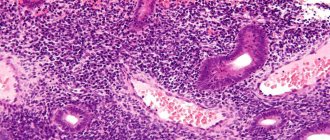Hypomenorrhea is a decrease in the amount of menstrual flow. When such a pathology appears, their volume does not exceed 50 milliliters per cycle. Often, with such changes, a reduction in the duration of regulation is observed; this phenomenon is called “oligomenorrhea”. The consequence of such conditions may be the cessation of monthly menstruation - amenorrhea.
Treatment for hypomenorrhea depends on the cause that caused it. In some cases, therapy is not required.
The concept of hypomenorrhea
Hypomenorrhea is a menstrual disorder characterized by a decrease in the volume of menstrual flow. Simply put, this pathology is called scanty menstruation. This is a condition associated with disruption of various functions of systems and organs of the female body.
When this pathology appears, only 25% of women are diagnosed with serious diseases that require treatment. Basically, such changes are associated with reasons that do not pose a threat to life and health. Such conditions do not require therapy and go away on their own. At the same time, the menstrual cycle is normalized.
Hypomenorrhea is often accompanied by other disorders:
- oligomenorrhea – a decrease in the duration of menstruation to 3 days or less;
- opsomenorrhea - an increase in the cycle. It can exceed 35 days;
- spaniomenorrhea - rare periods that appear no more than 4 times a year;
- dysmenorrhea - the appearance of menstrual pain of varying intensity.
Sometimes hypomenorrhea can be a consequence of pregnancy. To recognize the true cause of the development of this condition, you need to consult a doctor.
What is hypomenorrhea?
Hypomenorrhea, as this phenomenon is scientifically called, does not always indicate the presence of serious pathologies in a woman’s body. This phenomenon may even be associated with exogenous factors - time zone change, acclimatization, psychological stress, or a strict diet.
The causes of scanty periods can also be pathological, and since you are not a doctor and cannot make a correct diagnosis yourself, we advise you to contact your observing gynecologist to find out the causes of this disorder.
You should know that hypomenorrhea can be primary and secondary.
- Primary hypomenorrhea means that there were always scanty periods, and there was almost no heavy discharge;
- Secondary hypomenorrhea means that a woman's menstruation has always been normal, and became scanty for the first time, which made her really wary.
Symptoms
There are several signs of hypomenorrhea. But the main one is the nature of menstrual flow. In the presence of this pathology, menstruation takes on the appearance of several drops of blood. Because of this, women notice only dark or light brown marks on sanitary products or underwear.
Other symptoms of hypomenorrhea include:
- headache during menstruation;
- discomfort in the chest area;
- emotional swings;
- spread of pain in the lower abdomen;
- nausea during menstruation;
- presence of heartburn;
- increased appetite;
- decreased libido;
- dysfunction of the gastrointestinal tract, stool disorder;
- the appearance of itching and burning in the intimate area;
- decreased duration of menstruation;
- nosebleeds;
- the appearance of clots in menstrual flow;
- slight increase in temperature;
- development of chronic fatigue;
- increased sweating;
- increased thirst.
Often the pathology is practically asymptomatic, with the exception of a decrease in the amount of blood released.
If scanty bleeding appears after 40 years, this may indicate premenopause. This condition of the female body can be recognized by the following symptoms:
- hot flashes;
- decreased libido;
- increased sweating;
- sudden increase in heart rate;
- the appearance of dizziness, headaches;
- changes in emotional background;
- sleep disturbance.
If a woman has a concomitant gynecological disease, along with scanty blood discharge, symptoms corresponding to the pathology will appear.
Symptoms of pathology
Menstruation without blood is the main sign of hypomenorrhea. Traces of brown discharge or a drop of red blood remain on the laundry. The duration of menstruation itself may remain the same. But in most cases this is also reduced.
The woman's health is deteriorating. PMS symptoms are present. The main manifestations of hypomenorrhea:
- headache;
- constipation or diarrhea;
- nausea;
- lower back pain;
- chest discomfort;
- indigestion, exacerbation of gastritis;
- irritability;
- depression;
- depression;
- insomnia;
- dizziness;
- daytime sleepiness;
- lower abdominal pain.
The symptoms are almost the same as during normal menstruation. But fluid retention has been present for much longer. Hence the increase in body weight. Sometimes the impaired outflow of blood from the genitals is compensated by nosebleeds.
Causes
There are several causes of hypomenorrhea. Conventionally, they are divided into two groups: physiological and pathological. Doctors say that hypomenorrhea is not a pathology, but only a symptom of a developing disease or functional malfunction in the female body.
Physiological changes may appear in adolescence during the formation of the menstrual cycle. A similar condition can develop at the onset of menopause, as well as during breastfeeding.
Among the pathological causes, the following diseases are distinguished:
- hyperprolactinemia;
- development of a tumor in the pituitary gland;
- the appearance of a tumor in the adrenal glands that produces male sex hormones;
- pathologies of the thyroid gland, characterized by a decrease or increase in its activity;
- dysfunction of the ovaries due to polycystic disease;
- tuberculous endometritis.
Also, the cause of hypomenorrhea is premature menopause.
In some cases, pathology may develop:
- due to anorexia nervosa;
- anemia;
- chronic stress;
- psychological trauma;
- intoxications of various types.
Sometimes hypomenorrhea occurs after Duphaston, as well as when using other hormonal medications that have an anti-estrogenic effect. Infection of the internal reproductive organs during intrauterine intervention, the formation of adhesions inside the uterus can also provoke scanty periods. This symptom can also occur due to improper selection of hormonal contraceptives.
The above reasons contribute to problems with the blood supply to the endometrium and its changes during the menstrual cycle. If such a symptom appears, you must immediately consult a doctor to diagnose the cause of the disease.
Hypomenorrhea is often accompanied by a lack of estrogen in the body and ovulation disorders. Therefore, the likelihood of pregnancy in the presence of such a symptom decreases, and the more scanty the discharge, the less chance of conceiving a child. Sometimes infertility occurs with this pathology.
If light spotting appears during pregnancy, it does not indicate hypomenorrhea, but indicates the likelihood of a miscarriage.
Hypomenorrhea: what is it, causes of scanty periods, symptoms and treatment
Hypomenorrhea is a health condition in which the menstrual flow is very low. Characterized by scanty menstrual bleeding.
Unfortunately, many women have to deal with such a problem as hypomenorrhea, but few of them seek advice from a doctor, which is wrong.
A failure in the cycle necessarily signals some changes in the woman’s body.
What is hypomenorrhea
Hypomenorrhea is scanty discharge during menstruation in a volume of less than 50 ml (the norm is 50-150 ml). Also, the duration of menstruation is reduced to only two days (the norm is 5-7 days).
Hypomenorrhea is considered an acceptable norm only when taking hormonal contraceptives.
Causes
Most often, scanty periods are not a serious condition, but it is important to diagnose the underlying cause to avoid future complications.
The causes of scanty discharge during menstruation can be:
- anorexia nervosa or bulimia;
- obesity;
- avitaminosis;
- anemia;
- thyroid diseases;
- a consequence of abortion or curettage;
- congenital anomaly of the uterus;
- consequences of operations in the pelvic area;
- a sharp increase in psycho-emotional stress;
- excessive physical activity;
- tuberculosis of the genital organs;
- period of pregnancy and lactation;
- the period before the onset of menopause;
- STD;
- radioactive and chemical exposure;
- inflammatory processes in the uterus;
- first menstruation during adolescence.
Sometimes the main causes of this unpleasant condition may simply be vitamin deficiency, anemia, or it may be caused by emotional or psychological trauma.
A life-changing event, a stressful period of life or loss, or just one major shock in a woman's life is enough for her menstrual cycle to be disrupted for some time.
This situation may resolve over time.
Symptoms of hypomenorrhea
Possible symptoms may include:
- decreased amount of blood;
- the appearance of “daub”;
- headache;
- vomit;
- nagging pain in the lower abdomen;
- constipation;
- decreased sex drive;
- dyspepsia (disruption of normal stomach activity).
Symptoms in the presence of diseases that cause hypomenorrhea
Tuberculosis of the genital organs:
- constant temperature 38°C;
- lack of appetite;
- mental disorders;
- chronic endometritis;
- unpleasant odor of discharge;
- constant and periodic pain in the lower abdomen;
- temperature increase.
Chronic adnexitis:
- aching pain in the groin;
- feeling of heaviness in the appendage area;
- temperature increase.
STD:
Underdevelopment of the uterus:
- sharp pain during menstruation.
Uterine fibroids and hyperplasia:
- dark brown, not profuse discharge.
Types of scanty periods
There are two types of hypomenorrhea:
- primary. Scanty periods are observed in a teenager during the formation of menstruation and remain so for more than a year;
- secondary. It appears in mature women with normal discharge during menstruation, which later becomes scanty.
Types of scanty periods
There are several types of bad periods:
- hypomenorrhea (small amount of blood released);
- spaniomenorrhea (rare menstruation, about 4 times a year);
- oligomenorrhea (short duration of menstruation);
- opsomenorea (long periods of time between menstruation).
Scanty periods during pregnancy
Lack of menstruation is the main sign of pregnancy.
But, from the first month, the hormonal background of the expectant mother does not experience significant changes, so there may be scanty discharge, or full menstruation is a variant of the norm.
But in the future, the appearance of spotting during pregnancy may indicate:
- low progesterone;
- increased androgen levels (may be a sign of a threatened miscarriage);
- poor blood flow in the fertilized egg (threat of miscarriage);
- ectopic pregnancy.
Treatment
Since the nature of the appearance of hypomenorrhea can be very diverse, treatment is carried out symptomatically:
- for hormonal imbalances, this is treatment with hormonal drugs;
- for inflammations of various types - complex treatment with antibiotics.
The only general indications are:
- refusal of strict diets;
- rejection of bad habits;
- psychotherapy (if the disease is caused by a psychoemotional disorder).
Drug treatment
Drugs are selected solely based on the diagnosis itself. But there is a small list of medications that are used in almost every case:
- Duphaston;
- Qi-Clim;
- Estrovel;
- Remens.
Surgery
Surgery is necessary if the cause is:
- synechia (sticking together of the labia minora);
- cancerous tumors;
- benign tumors.
Complementary and alternative treatments at home
There are several other alternative treatments for hypomenorrhea, but before you try them, you should consult with your doctor.
Nutrition and supplements
When fighting hypomenorrhea, it is important to maintain proper nutrition, because often the cause of scanty discharge during menstruation is precisely hunger strikes and strict diets. General treatment also includes taking complex vitamin preparations.
Traditional medicine recipes
Treatment with folk remedies is also widespread, such as:
1. Decoction of onion peels:
- 200 gr. Onion peel;
- 0.5 liters of boiling water.
Leave to cool for 20 minutes. Take 2 times a day, half a cup
2. Quinoa tincture:
- 20 gr. Quinoa;
- 50 ml. Boiling water.
Leave until it boils. Take a cup 3 times a day.
3. Oregano tincture:
- 100 gr. Oregano;
- 20 ml. Vodka.
Leave for 3 weeks. Shake occasionally. Strain and drink 3 times a day, 30 drops.
4. Verbena decoction:
- 25 gr. Verbena;
- 500 ml. boiling water
Insist for a day. Drink during the day.
5. A decoction of St. John’s wort grains and thorn flowers:
- 40 gr. St. John's wort and thorn flowers;
- 500 ml. Boiling water.
Source: https://tvojajbolit.ru/ginekologiya/gipomenoreya-chto-eto-takoe-prichinyi-skudnyih-mesyachnyih-simptomyi-i-lechenie/
Diagnostics
Laboratory tests in gynecology make it possible to accurately diagnose the cause of hypomenorrhea. The gynecologist will prescribe the woman an examination, which includes:
- taking anamnesis;
- gynecological examination;
- testing for cytology, culture, PCR diagnostics of sexually transmitted infections;
- analysis of the basal temperature chart;
- determination of hormone levels in blood and urine;
- Ultrasound of the reproductive system;
- histological examination of the endometrium;
- biopsy - if necessary.
Only after making an accurate diagnosis will the doctor be able to prescribe the optimal treatment regimen for the identified pathology.
Why does the disease occur?
Heavy and frequent menstruation can be primary, which is observed in a woman from the moment the cycle begins, and secondary, which differs from normal discharge. Pathology in both cases requires consultation with a doctor.
Experts name a large number of reasons for heavy, long menstruation, which can be associated with pathologies of the reproductive system, as well as with general diseases or external influences.
Hormonal imbalances are one of the particular causes of heavy menstruation; they often occur during puberty, menopause, and when the cycle is restored after the birth of a child. The mechanism of the disease is a violation of the ratio of progesterone and estrogen.
Common causes of long, heavy periods can be sexually transmitted infections and diseases of the reproductive system, including cancer. Pathologies occur in most cases due to unstable hormonal levels. In 80% of cases, hypermenorrhea occurs in connection with these phenomena.
The general condition of the body also affects the nature of the cycle. Very heavy menstruation can be caused by:
- disturbances in the functioning of the thyroid gland, heart, liver, kidneys, pelvic organs;
- low blood clotting;
- thin, fragile vessel walls.
Due to the variety of factors that cause hypermenorrhea, the patient should be examined not only by a gynecologist, but also by a therapist and an endocrinologist to exclude systemic diseases.
Excessive periods can also have external causes:
- excessive physical activity;
- mental stress, stressful situations;
- installation of contraceptives, for example, IUDs;
- violation of the medication regimen, including contraceptives;
Important! Prolonged exposure to the sun, a hot shower or bath provoke an increase in the amount of discharge during menstruation.
Treatment of hypomenorrhea
Treatment of hypomenorrhea depends on the cause that provokes its occurrence. If scanty periods were caused by poor diet, intense physical activity, or stressful situations, the woman is advised to change her lifestyle. In this case, the menstrual cycle can recover on its own.
In the presence of concomitant pathologies, doctors often prescribe therapy with anti-inflammatory, antimicrobial, hormonal drugs, as well as restorative drugs, complexes of vitamins and minerals. If scanty periods appear while taking oral contraceptives, the doctor recommends stopping them. In this case, the menstrual cycle will be restored immediately or after a short period of time.
Therapy with folk remedies and methods of traditional treatment are not required if hypomenorrhea was provoked by diagnostic procedures, childbirth, premenopause, or lactation. In these cases, you will need to consult a doctor to rule out the presence of gynecological pathologies and confirm the physiological course of the symptom that has arisen.
Hypomenorrhea in women: treatment, causes, symptoms, pregnancy – VSEMRT
Hypomenorrhea is one of the types of changes in the menstrual cycle, in which the amount of blood released during menstruation sharply decreases.
Scanty menstruation may be the norm during certain periods of a woman’s life, but during childbearing years, slight bleeding on the days of expected menstruation is a reason to consult a doctor: it is necessary to identify the cause of hypomenorrhea in time in order to prevent serious problems associated with women’s health. Menstrual dysfunction, which begins with irregular or scanty periods, leads to infertility, gynecological problems and amenorrhea. The primary stage of diagnosis is determining the level of hormones in the blood, ultrasound of the reproductive organs. In difficult cases, an MRI must be done. Drug treatment of hypomenorrhea is aimed at correcting the menstrual cycle, which will become the basis for restoring women's and reproductive health.
Variants of hypomenorrhea
Hypomenstrual syndrome manifests itself in several types of menstrual irregularities. Most often there are:
- scanty periods (hypomenorrhea);
- shortening the duration of critical days (oligomenorrhea);
- rare menstruation arriving late (opsomenorea).
Hypomenorrhea can be the first sign of hormonal imbalance, which can result in infertility and amenorrhea.
Folk remedies
Hypomenorrhea can occur after a severe stressful situation, serious illness and a sharp weakening of vitality.
It is possible to use unconventional methods and herbal preparations for scanty periods, but only after a medical examination.
For tumors and serious hormonal imbalance, herbal preparations will not give any positive effect. Folk remedies as part of a comprehensive course of therapy will help in the following cases:
- recovery after illness;
- anemia;
- fast weight loss;
- weakness;
- depressive state.
Decoctions and infusions of the following herbs will provide a good effect:
- verbena;
- oregano;
- elecampane;
- shepherd's purse;
- lovage
Verbena
The selection of a treatment regimen with folk remedies must be agreed with a doctor to ensure optimal treatment results.
Pregnancy with hypomenorrhea
Regardless of the reason, scanty periods indicate that the reproductive system is not ready to conceive and bear a fetus. It will take time and patience to restore reproductive function and create conditions for the desired pregnancy.
The effectiveness of treatment and restoration of fertility depends on the diagnosis: for functional disorders, drug therapy is used, for tumors and malformations, surgery will be required, followed by drug treatment.
The prognosis for pregnancy with scanty periods is favorable against the background of:
- functional hyperprolactinemia;
- hyperandrogenemia of non-tumor origin;
- chronic endometritis;
- scleropolycystic ovarian disease;
- diseases of the thyroid gland.
Significantly less chances for the desired conception with the following diseases:
- tumor or hemorrhage in the pituitary gland;
- gross congenital malformations of the reproductive organs;
- hormonally active neoplasms of the ovaries and adrenal glands;
- ovarian wasting syndrome with early menopause.
For each woman with a pathology of the reproductive system, treatment is selected individually. The prognosis for pregnancy may change after surgery or the positive effect of drug therapy.
Source: https://vsemrt.ru/zabolevaniya/gipomenoreya/
Possible complications
If hypomenorrhea is pathological, lack of treatment may lead to the development of some complications. These include:
- inability to get pregnant or decreased likelihood of conceiving a child;
- cycle disruption until menstruation disappears;
- frigidity;
- increasing the likelihood of an ectopic pregnancy.
To avoid these problems, you need to consult a doctor in a timely manner, follow all his recommendations, and eat properly and nutritiously. It is also necessary to protect yourself from stress, sexually transmitted infections, and uncontrolled use of medications. If all the rules are followed, a woman will be able to completely overcome the disorder and normalize the menstrual cycle.
Is it possible to get pregnant
Patients with hypomenorrhea are actively interested in whether it is possible to become pregnant, carry and give birth to a healthy baby. This condition may not cause infertility, but it does indicate problems with ovulation. The reproductive system malfunctions, and accordingly, there may be difficulties with conception.
People begin to talk about infertility when even scanty discharge disappears. Such a situation can be called critical, so a woman who wants to become a mother must clearly monitor the cycle and the nature of the discharge.
In some cases, women confuse small spotting with menstruation during pregnancy. In fact, this is an alarming signal warning of a threat to the developing fetus. Spontaneous miscarriage may occur. You need to see a doctor urgently.
Regarding hypomenorrhea, doctors do not have clear recommendations for treatment. The more carefully a woman monitors her health and undergoes examinations, the less likely it is to develop abnormalities in the functioning of the genital organs.











